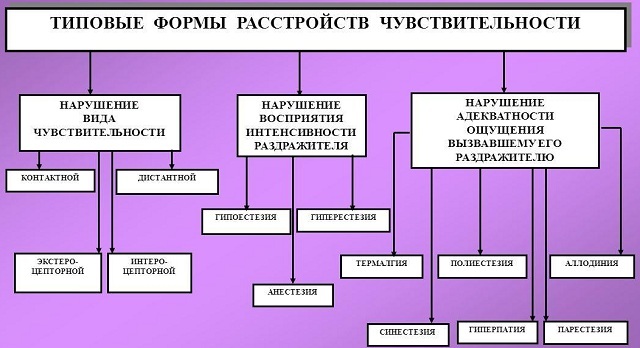 Hyperventilation syndrome( hereinafter, for convenience of DHW) is an breathing disorder associated with the psychic factors , which has a periodic or chronic course.
Hyperventilation syndrome( hereinafter, for convenience of DHW) is an breathing disorder associated with the psychic factors , which has a periodic or chronic course.
With acute , a sudden severe attack during a stressful situation.
Chronic course can last for years in the form of small difficulties in breathing. It is one of the symptoms of a panic attack.
Read more about panic attacks in our material.
 What can trigger a panic attack: symptoms and signs of a panic attack
What can trigger a panic attack: symptoms and signs of a panic attack According to statistics, the symptoms of a panic attack are manifested in 45-70% of the world population, which is an impressive figure. And often the first. ..
The disease was described in the nineteenth century as an acute respiratory disorder. Suffered mostly soldiers who participated in the fighting. The man gasped, while desperately trying to breathe, but because of nervous tension, only deterioration occurred.
Seizures usually last from a quarter to half an hour, but can sometimes stretch for hours. Physicians have determined that is the main culprit of syndrome is a strong stress.
At the present time, with increasing stressful situations, the number of cases of hyperventilation syndrome increases. If the syndrome is not treated, then it develops into an obsessive phobia because of the patient's fear of getting into a situation that provokes an attack, and fear itself provokes stress - we get a vicious circle.
 Do you think your wife behaves strangely and has lost her head? Learn the signs of neurasthenia in women.
Do you think your wife behaves strangely and has lost her head? Learn the signs of neurasthenia in women.
Can concussion and tremor of limbs be linked, as well as other possible causes of troubled arms.
Content
- Causes hyperventilation syndrome
- Symptoms DHW
- Treatment syndrome
- Breathing exercises
- Drug therapy
- Psychocorrection
- Video: Breathing exercises
Causes hyperventilation
syndrome breath affect the autonomic and somatic nervous systems of the body, that is, during emotional experiences( stress) changesthe nature of breathing - breathing often or vice versa rarely, one holds his breath, the other breathes superficially.
All this leads to a change in the acidity of the blood, which in turn causes disturbances in metabolism. And already this can serve as an impetus for the emergence of hot water.
There is a list of certain diseases that provoke dhw:
- tumors and injuries of the central nervous system;
- increased intracranial pressure;
- stroke;
- some congenital pathologies in development;
- fever;
- respiratory system diseases;
- shock caused by toxins of bacteria;
- stress, hysterical fits;
- pregnancy;
- AIDS, toxoplasmosis, rabies and other neuroinfections;
- heart disease;
- some medicines( eg progesterone, methixanthin).

Symptoms of DHW
The hyperventilation syndrome has such symptoms:
- rapid breathing;
- appearance of dyspnea;
- deep sighs with high frequency;
- dry cough with asthma attacks;
- impossibility of deep inspiration due to spasm;
- anxious feeling, panic attack;
- numbness of hands or feet, tingling in the fingers;
- surface or deep breathing;
- abdominal rash or constipation;
- insomnia;
- visual disorders;
- dizziness;
- incapacity;
- rapid fatigue and weakness throughout the body;
- muscle pain, spasms;
- trembling of limbs, tremor;
- muscle tone;
- sensation of dry mouth;
- increased body temperature and cooled limbs.
Treatment of the syndrome
Hyperventilation syndrome implies a comprehensive treatment. Here are three whales of the modern treatment:
Respiratory gymnastics
The main task of respiratory gymnastics in hyperventilation syndrome is the transition of the patient from the thoracic type of breathing, to the abdominal, which can be completely controlled with the help of consciousness. They achieve the normalization of the frequency of breaths, since the principle of feedback starts to work here.
Here are some of the exercises:
- We take a paper or plastic bag and intensively begin breathing in it, while the enrichment of the blood with carbon dioxide occurs, which stops the attack and normalizes the general state of the body.
- Abdominal breathing - breathe for 20 minutes according to the following scheme - we do a shallow short breath, then a long exhalation, while watching to keep the breathing even.
Medical therapy
An individual set of medications is selected, which can include anticonvulsant, cardiac rhythm regaining, psychotropic, sedative, calcium, magnesium and amino acid preparations, as well as beta-blockers.
In especially severe cases, appoint tranquilizers and antidepressants.
Psychocorrection
 The main goal- is gaining complete control over the patient's condition during extreme situations, the ability to combat nervous tension, anxiety and stress.
The main goal- is gaining complete control over the patient's condition during extreme situations, the ability to combat nervous tension, anxiety and stress.
To choose how to treat hyperventilation syndrome should a doctor who is trying to convey to the patient information about the disease in the most lucid manner. Awareness of all causes and mechanisms of the disease eliminates the patient's sense of fear of the unknown.
The earlier the disease is identified, the sooner it is possible to achieve a positive trend in the treatment of .Usually, with proper treatment, a full recovery comes in two to three months.
You also need to organize your day and exclude computer games, normalize sleep and emotional background at home and at work.
In conclusion, I want to say a few words about other histories related to hyperventilation.
Some people specifically deal with controlled hyperventilation, for example, for swimming. But there are methods in which by rapid deep breathing they achieve the entry of an organism into an altered state of consciousness.
They are distinguished by levels:
- rebuild - basic condition - used in psychotherapeutic and health practice;
- Holotropic Breathing is essentially an independent confluence into a hypnotic state that allows you to reopen, survive and overcome deep traumas or conflicts that were once forced into the subconscious and manifested as pathologies;
- vayvyshn - a special kind of meditation, which brings up a certain type of breathing - ideally a person has a constant light hyperventilation, which causes an increased content of endorphins( hormones of happiness) in the body.
Video: Respiratory gymnastics
For the correction of psychological respiratory disorders, special breathing exercises are used quite successfully.



